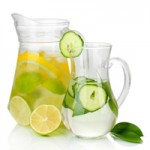It’s Toxic!

In today’s society we are exposed to more chemicals and pollutants than ever before, whether in the air that we breathe or the foods that we eat, it’s hard to escape. Next time you are out shopping, have a good look at the labels on some of the ready prepared and processed foods, spot how many ingredients you can’t even pronounce. These chemicals may be fairly simple to avoid, but how about those found in fresh foods, such as the antibiotics given to livestock or the pesticides used to grow fruit and vegetables? Even with a seemingly healthy and balanced diet, reducing the amount of chemicals we intake can prove to be a challenge.
Give your liver a break
Unsurprisingly, the increasing number of chemicals we consume on a daily basis is putting a strain on our bodies and on one organ in particular, our liver. One of its key roles is detoxification which can only take place if the necessary vitamins, minerals and amino acids found in the foods we eat are present. But if many of these foods contain chemicals themselves, it puts an extra pressure on the detox process. If the liver is overloaded and cannot break down these toxins they are stored in our fat cells to protect our vital organs.
But with a multitude of important roles the liver really does have a tough job; producing proteins, nutrients and chemicals that are essential for our bodies to function, whilst manufacturing hormones, breaking down fats and sugars, and storing a host of essential vitamins and minerals. Too much sugar, caffeine or alcohol in your diet creates further pressure and once again these unwanted toxins are stored in the body as the liver struggles to break them down.
So it’s easy to see how the liver can get into trouble, either as a result of nutritional deficiencies or additional chemicals that challenge detoxification.
Anything in moderation
As I always say, anything in moderation is a good ethos to follow. You can reduce your chemical intake by eating a diet that is high in fresh produce and choosing organic foods where possible, or thoroughly washing fruit and vegetables before eating. Cutting down your sugar, caffeine and alcohol consumption will of course give your liver an easier ride.
So how do you know if your liver is struggling? Here are some signs to look out for:
- Your skin – Liver dysfunction eventually reaches the surface. You may notice brown blotches (commonly known as liver spots), or red rashes such as rosacea or psoriasis.
- Hormonal issues – An overloaded liver will play havoc with your hormones, increasing PMT symptoms such as breast tenderness and cramping, or inducing severe hot flushes.
- A fatty liver – The digestive system will take a hit causing an intolerance to fatty foods and/or alcohol.
- Joint problems – Sulphur is not only vital in detoxing the liver but also acts as a ‘glue’ for our soft tissues; our joints, ligaments and cartilage would literally collapse without it. The liver takes priority on sulphur levels within the body so when the detox process is under pressure it leaves insufficient supplies elsewhere. Osteoarthritis can become a particularly common condition as a result.
Kath’s tips for a healthy liver
- Add a squeeze of lemon juice to a glass of filtered water and drink first thing in the morning, before you eat or drink anything else. This primes your liver and your digestive system for the day ahead.
- Drink at least 8 glasses/2 litres of filtered water daily, to help flush out the toxins through the bladder and bowels, preventing them from recirculating in the bloodstream.
- Eat sulphur-rich foods especially broccoli, garlic, onions and leeks, or take an MSM supplement.
- Eat dark coloured fruit and vegetables such as blueberries, beetroot and blackberries which are high in antioxidants.
- Drink milk thistle tea or take either a milk thistle supplement or a supplement that contains herbs, vitamins and minerals, to support your liver.
- Do a detox! This is the most important and effective solution in giving your liver a break. If you would like some advice or guidance on this do get in touch.
